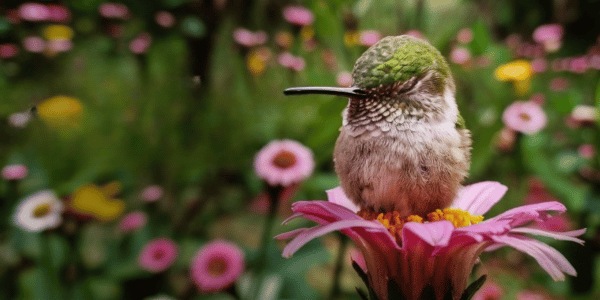Hummingbirds, with their dazzling iridescent feathers and rapid wingbeats, are among the most fascinating creatures in the avian world. These tiny birds, often weighing less than a nickel, are known for their incredible energy, flitting from flower to flower with astonishing speed and precision.
However, just like all living beings, hummingbirds need rest to maintain their vitality. Here, we study various aspects of the sleep patterns of hummingbirds and how these small dynamos recharge themselves for another day full of action-packed activities.
Interesting Facts about Hummingbirds & Sleep
Hummingbirds possess several curious traits concerning sleep, which emphasize their ability to adapt and endure:
Energy Conservation: They use up to 90% less energy during torpor, enabling survival through the night and readiness for feeding at dawn.
No Birdhouses: Even though they are miniature, hummingbirds do not sleep in birdhouses. They prefer thick vegetation that provides better protection.
Solitary Sleepers: Unlike other bird species that sleep together in groups known as roosts, hummingbirds sleep alone in a place hidden from danger.
Shut Eyes: Hummingbirds always sleep with closed eyes, so if you see a perched hummingbird with open eyes, it’s awake and alert.
Nighttime Activity: If you notice a hummingbird flying at night; it may be migrating. Turn off lights to help them reorient so they avoid hitting things while flying around.
You May Also Like: Make the Perfect Hummingbird House Today: Expert Advice

Why Do Hummingbirds Need Sleep?
Sleeping is an essential life process crucial to all animals’ survival. For hummingbirds, this need is even greater because of their abnormally high metabolism. A hummingbird’s heart can beat more than 1200 times every minute, and its wings can flap up to 80 times per second.
This level of activity requires very high amounts of energy, which these birds get from nectar and tiny insects. Nevertheless, irrespective of efficient energy intake processes, these birds require periods of rest to recover from metabolic strains associated with routine duties.
Metabolic Demands and the Role of Sleep
The Ruby-Throated Hummingbird consumes nectar continuously throughout the day to meet its need for energy (Taylor et al., 2006). Due to its small size and high metabolism, these species have very little adipose tissue, hence their feeding quite regularly.
During daylight hours, hummingbirds become hyperactive, and their metabolic rates are among the highest among all animals worldwide. But at nightfall, temperatures and food availability sharply decrease. This explains why sleep and torpor, a unique adaptation, play vital roles here.
Understanding Torpor: Hummingbird’s Sleep Strategy
What is Torpor?
Torpor is a deep, hibernation-like sleep that Hummers experience at night or when it is very cold. In contrast to normal sleep, torpor dramatically lowers the bird’s metabolic rate, body temperature, and heart rate.
In this state, a hummingbird’s body can cool off to almost the ambient temperatures, sometimes as low as 10°C (50°F), which is quite different from their daily average of 40°C (104°F). This physiological adaptation enables hummers to save energy that is necessary for their survival.
How Torpor Differs From Regular Sleep
In birds, normal sleep involves periods of REM (Rapid Eye Movement) and non-REM sleep, during which the brain remains relatively active and basic bodily functions are maintained at their usual levels, instead of sleeping, though, during torpor, a hummingbird’s body virtually shuts down.
Their heartbeat can drop from about 1200 beats per minute to just around 50 while they barely breathe. Hence, this form of suspended animation allows them to survive long periods without feeding, such as overnight or when foraging is impossible due to poor weather conditions.
Duration and Frequency of Torpor
Hummingbirds usually enter torpor every night, the time taken in it dependent upon the environmental conditions. However, during colder climates or very cold nights, the bird can remain in this state for longer, hence allowing it to keep as much energy as possible.
However, there are some risks associated with this process since a hummingbird takes approximately an hour to regain its body temperature and metabolic rate after sleeping. During this period of vulnerability, its reactions are significantly slowed, making it more susceptible to predators.
You May Also Like: Hummingbird Dreams: Symbolism and Significance

Where Do Hummingbirds Sleep?
Selecting the Perfect Roosting Spot
Hummingbirds are solitary sleepers. They usually choose to roost in secluded and sheltered spots that offer protection from predators and the elements. They sleep on thin branches deep within the foliage, where they are less likely to be disturbed. A few species prefer to get used to sleeping in one place, whereas others will vary their roosts based on availability and safety.
The Role of Camouflage
Camouflage is very important when selecting where a hummingbird should sleep. Despite being brilliant during daylight hours, the birds’ conspicuous colors at night may attract nighttime predators capable of attacking them anytime. Consequently, these birds go for places that merge with their surroundings using leaves covering twigs or even bodies so that nocturnal hunters such as owls and snakes would not see them.
Do Hummingbirds Sleep in Nests?
It seems paradoxical, but not all hummingbirds use nests for sleeping purposes. Nests are mainly built specifically for brooding young, which usually makes them exposed or potentially uncomfortable to sleep in after fledging. As such, these birds prefer places with dense foliage or trees’ forks and crooks where they cannot be seen/ detected.
The Challenges of Hummingbird Sleep
Predation Risk During Sleep
Despite their small size, hummingbirds are preyed upon, thus dictating their sleep patterns, which help them evade enemies who hunt at night. In addition, while in torpor, the birds are almost paralyzed and can be easily eaten up by predators in case they are detected. Consequently, they select their sleeping spots very carefully, making it hard for larger animals to go there.
Energy Conservation vs. Vulnerability
Keeping a balance between saving energy and staying clear of enemies is not easy for these tiny beings. When in torpor, they do not expend all the calories accumulated during the daytime, which also increases their chances of being caught by predators. This is the constant problem hummingbirds have to face, especially when living in environments with limited food sources but rich food for predators.
You May Also Like: What Color Attracts Birds To a Bird Bath?What Birds Love

Hummingbirds’ Waking Routine: Returning From Torpor
The Process of Waking Up
Emerging from this state is a gradual process for hummingbirds as their body temperature needs to increase alongside their metabolic rate back to normal levels, which requires a lot of energy. As sunlight increases together with warmth, raising ambient temperatures serves as stimuli that make the bird start reversing torpidity. During this period, the hummingbird will stay relatively motionless so as to save its energy until it gets fully alert and ready for feeding again.
Immediate Need for Food
As soon as the hummingbird gets up, it has to look for food. The bird has not been eating for some hours and thus has a lack of energy. Most times, they will fly straight to where they know there is food, such as their favorite flowers or feeders, where they consume nectar that their high-energy life demands in no time.
Conclusion: The Vital Role of Sleep in Hummingbird Survival
Hummingbirds’ sleep patterns are an amazing adaptation to their ecological niche. These birds go into torpor, which helps them conserve energy and sustain a high metabolic rate, allowing them to survive harsh environmental conditions.
Understanding how and why hummingbirds sleep demonstrates their incredible resilience and highlights the fine balance needed between keeping warm (energy conservation) and staying safe from predators.
Hummingbirds continue to captivate scientists and bird enthusiasts alike, and their sleep habits offer just one more fascinating insight into their lives. As we learn more about how hummingbirds rest and rejuvenate, we gain a deeper appreciation for the complex strategies that enable them to thrive in the natural world.
FAQs
What is torpor in hummingbirds?
Torpor refers to a state similar to hibernation that allows hummingbirds to save energy. During torpor, a bird’s heart rate, body temperature, and metabolic rate (MR) lower significantly, enabling it to survive overnight or during extreme cold without feeding.
How long does a hummingbird stay in torpor?
Hummers stay in Torpor for much of the night. Although the duration may vary due to environmental factors, it often lasts from dusk until dawn.
Where do hummingbirds sleep?
Typically, Hummers find secluded spots, such as deep foliage on thin branches, for sleeping purposes. They do so because such places offer protection against predators or harsh weather conditions.
Do Hummingbirds Sleep In Their Nests?
Sleeping usually occurs in places other than the nests themselves, which are mainly meant for bringing up chicks. Once they have matured, hummingbirds tend to sleep elsewhere.
Do Hummingbirds Sleep All Night?
Yes, hummingbirds tend to have a full night’s sleep, which allows them to maintain their high-energy activities throughout the day.
How Can You Tell If a Hummingbird Is Sleeping?
A sleeping hummingbird will typically perch with its eyes closed and its bill pointed upwards. An upside-down hanging hummer? It is asleep and will wake up on its own later!
Do Hummingbirds Sleep in the Same Place Every Night?
Sometimes, Hummers can sleep in the same place repeatedly, but they also move around or change locations, just like we do when we want to stay safe from predators or changing weather conditions.
Where Do Hummingbirds Nest?
Hummers nest in bushes and trees, usually near water bodies. They also nest on wires and inside sheds, selecting areas that offer shelter from harsh weather conditions and proximity to food sources.












One Response